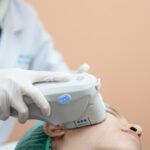At Mirror Mirror Beauty Boutique in Houston, TX, we believe taking care of your skin is important. Monthly skin treatments allow you to pay close attention to your skin’s specific needs with care that’s just right for you. Under the leadership of skilled cosmetic surgeon Dr. Paul Vitenas, our team uses the most up-to-date technology… [Read More]
Blog
The Benefits and Limitations of Non-Surgical Skin Tightening using Ultherapy: What You Need to Know
Ultherapy non-surgical skin tightening uses ultrasound technology as a way to make the skin look firmer without needing surgery. It has become a favorite choice for people looking to improve their skin’s appearance without undergoing traditional surgical methods. For those thinking about cosmetic enhancements, Ultherapy presents an attractive option. We will look into the advantages… [Read More]
How Many Xeomin or Botox Units Do You Need? 6 Facts You Should Know
Knowing the average amount of Botox units needed is helpful when considering an injectable treatment. Mirror Mirror Beauty Boutique provides essential info to help you estimate the overall price of your treatment, though only Dr. Vitenas will know exactly how many units you will need. Future patients are always curious about the number of units… [Read More]
Ulthera or Traditional Facelift: Which will benefit you the most?
The aging process, sun exposure, and certain lifestyle habits eventually cause your skin to lose some of its elasticity and begin to sag and wrinkle. Wrinkled, sagging skin can add years to your appearance and make you look tired, worried, or angry. Fortunately, multiple options are available to minimize sagging skin and wrinkles and turn… [Read More]
Key Benefits of Microneedling With Exosomes
Microneedling with exosomes is a modern skincare procedure that enhances the skin’s texture, look, and health. It merges the well-known advantages of microneedling with the healing abilities of exosomes. Dr. Paul Vitenas offers specialized and results-oriented treatment in this field, using his vast experience in aesthetic medicine to improve skin rejuvenation. Boost Your Skin Health… [Read More]
VI Peel or Regular Chemical Peel? Find Your Ideal Skin Solution
Choosing the right skin treatment between a VI Peel and a regular chemical peel can make a big difference in achieving your skincare goals. These two options have their own benefits, which vary depending on your skin type, the specific skin problems you’re trying to address, how quickly you want to see results, and how… [Read More]
Ulthera for Neck and Chest: Revitalize Overlooked Areas
Ultherapy, often utilized for facial rejuvenation, is an effective method for tightening skin on the neck and chest, areas that are frequently overlooked when addressing signs of aging. At Mirror Mirror Beauty Boutique, we offer this non-surgical treatment to help our patients look younger by tightening their skin in these areas. By choosing Ultherapy, people… [Read More]
Exploring the Long-Term Effects of Ulthera: Sustaining Youthful Results
Ultherapy, also known as Ulthera, is a non-invasive treatment designed to firm and refresh the skin using sound waves. By stimulating collagen growth, it’s become a favored choice for people who want to look younger without undergoing surgery. At Mirror Mirror Beauty Boutique, we provide a clear understanding of the durability of Ultherapy results. We… [Read More]
Unlocking Youthful Skin with Ulthera: What to Expect from Treatment
Ultherapy is a non-surgical treatment that uses ultrasound technology to lift and rejuvenate the skin. This procedure aims to improve your appearance by tightening skin and reducing wrinkles without the use of invasive surgical methods. At Mirror Mirror Beauty Boutique, we provide detailed information about who is a good fit for Ultherapy, how to get… [Read More]
Understanding Ulthera: How Ultrasound Technology Transforms Skin Tightening
Ultherapy, sometimes called Ulthera, harnesses ultrasound technology to lift and firm the skin non-surgically. It encourages the body to produce more collagen, which helps the skin look younger and tighter. At Mirror Mirror Beauty Boutique, we specialize in Ultherapy treatments. Our aim is to give you a clear understanding of what the treatment entails, its… [Read More]
- 1
- 2
- 3
- …
- 25
- Next Page »










